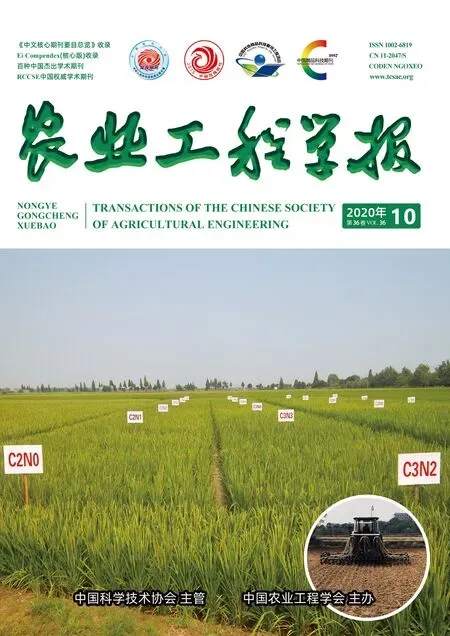春秋季对近红外光谱模型预测奶牛场粪水氮磷含量结果的影响
孙 迪,杨仁杰,李梦婷,牟美睿,李明堂,张克强,赵 润
春秋季对近红外光谱模型预测奶牛场粪水氮磷含量结果的影响
孙 迪1,杨仁杰2,李梦婷3,牟美睿2,李明堂1,张克强3,赵 润3※
(1. 吉林农业大学资源与环境学院,长春 130118;2. 天津农学院工程技术学院,天津 300384;3. 农业农村部环境保护科研监测所,天津 300191)
为研究季节因素对规模化奶牛场粪水氮磷含量及其近红外光谱模型预测结果的影响,该研究采集了天津市春秋双季27家规模化奶牛场粪水处理全过程的250个粪水样品,解析了季节对粪水氮磷含量分布特征的影响,同时采集了所有样品的近红外光谱并进行主成分分析。采用偏最小二乘法(Partial Least Squares,PLS)建立了粪水氮磷季节内预测模型,包括春秋单季和双季融合模型以及季节间的相互预测模型。结果表明,粪水氮磷含量随季节变化呈现出差异性,季节内模型总体的预测效果较好,优于季节间模型;其中春季模型表现最佳,验证相关系数分别为0.98和0.90,剩余预测偏差(Residual Predictive Deviation,RPD)分别为4.67和2.03。研究表明,季节因素对粪水中氮磷含量的模型预测结果存在不同程度的影响,该研究可为建立全季节要素的综合模型提供依据。
氮;磷;粪水;规模化奶牛场;近红外光谱;偏最小二乘;季节内模型;季节间模型
0 引 言
现阶段,中国奶牛养殖业在规模化快速发展的同时也面临诸多环境问题,其中每天产生的大量粪水和沼液的出路问题尤为突出且日趋严峻[1-3],是阻碍奶业绿色健康发展的重要瓶颈。还田农用是粪水和沼液的最佳出路,氮磷是重要的养分衡量指标。然而受温度、风速、降雨等自然环境因素的影响,粪水中氮磷组分含量差异大[4-8],难以在现场快速准确定量,导致粪水还田难。近期中国职能部委发布的指导意见[9-12]中明确要求,要健全粪水还田利用和检测方法标准体系,科学确定有害物质限量。为此,研究典型季节对规模化奶牛场复杂粪水体系中氮磷含量变化及其快速定量方法的影响机制,为建立粪水还田检测方法标准体系进而指导粪水安全、科学还田并降低环境风险提供依据,具有重要的理论和实践意义。
相比传统的实验室化学分析方法,近红外光谱(Near Infrared Spectroscopy,NIRS)技术具有快速、高效、对样品无损、重现性好等优点,被广泛应用于环境[13-16]、石油化工[17-18]、食品[19-21]等诸多领域,在畜牧环境工程中主要应用于粪便、堆肥和有害气体等的检测[22-25],许多学者融合多元校正方法建立了近红外光谱定量分析模型实现未知样品浓度的预测,然而受不同情境下多种因素的相互作用,样品性状特征会发生改变,从而影响模型预测性能。如Finzi等[26]应用NIRS分析了奶牛场和猪场中共36个粪浆和沼渣样品中的总固体、凯氏氮、氨氮和挥发性脂肪酸,评估样品制备方法、样品杯材质及温度对模型性能的影响,结果表明对粪浆和沼渣采取过滤的方式有利于获得更好的预测结果,皮式培养皿做样品杯的效果要优于光学纤维,10~35 ℃的变温区间内模型预测结果没有显著差异。此外,本课题组利用近红外光谱技术对23家规模化奶牛场粪水氮磷含量建立了定量分析模型[27],指出受养殖规模、清粪方式和处理工艺等因素影响,模型适用性和稳定性有待进一步提升,应将开展典型季节对模型预测性能的影响分析,建立适合于不同情境下规模化奶牛场粪水氮磷的定量分析模型,为粪水还田提供理论依据。
因此,本研究以春秋季天津市27家种养结合型规模化奶牛场粪水处理全过程的样品作为研究对象,从化学值统计分析、近红外漫反射光谱的主成分分析以及季节内和季节间模型比对分析3个方面,系统研究季节因素对粪水氮磷定量分析模型的影响机制,为建立全季节要素下规模化奶牛场粪水氮磷含量的现场速测方法提供理论依据。
1 材料与方法
1.1 研究区概况
选取天津市5大奶业优势产区(宁河、滨海、武清、静海、宝坻)共27家种养结合型规模化奶牛场开展监测采样,各场所在地区、养殖规模、清粪方式、处理工艺等情况如表1所示,所选奶牛场全面覆盖天津市中型、大型和特大型3种存栏规模,5种清粪方式及5种粪水处理工艺,代表全市奶牛养殖整体情况。

表1 27家种养结合型规模化奶牛场情况信息表
注:中型(200~999头)、大型(1000~4999头)、特大型(>5000头),引自《规模畜禽养殖场污染防治最佳可行技术指南(试行)(HJ-BAT-10)》。
Note:Medium type (200-999 headage), large type (1000-4999 headage), super type (>5000 headage), which was quoted from the().
1.2 粪水样品采集
1.2.1 奶牛场位置和采样数量分布
天津属季风气候,四季分明,春季多风,干旱少雨,降雨量约占全年总量的12%;秋季气候温和,降水量较春季多,约占全年总量的14%。分别于粪水集中还田前的4月和10月到各场采样,每天到达某一地区的2~7家奶牛场,共采集13~31个样品不等,每家奶牛场2~10个样品不等,27家奶牛场位置和采样数量分布如图1所示。

注:黑色圆点为采样奶牛场位置。
1.2.2 样品采集位点
样品采集于春秋双季天津市27家奶牛场粪水处理过程中的各个环节,样品采集参照《GB/T 27522-2011畜禽养殖污水采样技术规范》[28],从奶牛场粪水收储设施原点集粪沟或集污池开始,到粪水还田前节点氧化塘或贮存池为止,其中包含集粪沟、集污池、分离池、调节池、沉淀池、贮存池和氧化塘等,共采集了250个粪水样品,即时送至实验室测定样品氮磷含量,同时扫描近红外漫反射光谱。粪水处理路线及采样位点分布如图2所示。

注:¬为采样位点。
1.3 测试方法
参照国标GB 11891-1989《水质-凯氏氮的测定》[29]方法测定粪水样品中总氮(Total Nitrogen,TN)的含量。仪器选用全自动凯氏定氮仪(Foss kjeltec 8400型,Denmark)。按照 GB 11893-1989《水质-总磷的测定-钼酸铵分光光度法》[30]中规定方法测定粪水中总磷(Total Phosphorus,TP)的含量,仪器选用紫外可见光分光光度计(722E型,China)。表2为250个粪水样品TN和TP含量测定结果,浓度范围跨度很大。

表2 样品总氮和总磷测定结果
1.4 样品光谱信息采集
实验仪器为美国PerkinElmer(PE)公司的傅立叶变换近红外光谱仪,InGaAs检测器,仪器自带积分球附件,光谱扫描范围为4 000~12 000 cm-1。光谱扫描参数:分辨率8 cm-1,扫描间隔2 cm-1,扫描次数64。具体操作如下:将粪水样品装入样品杯中,规模化奶牛场粪水样品装入样品杯中,并放置在积分球旋转样品台上,以积分球内置参比为背景,分别采集每一个样品的近红外漫反射光谱。
2 结果与分析
2.1 季节对粪水氮磷含量变化的影响
27家奶牛场粪水TN和TP含量整体分布如图3所示。TN、TP含量总体呈正偏态(右偏)分布,其中TN质量浓度范围为14.16~6 207.40 mg/L,均值1 846.04 mg/L,标准差1 370.49 mg/L,变异系数0.74。TN浓度出现在1 000 mg/L左右的频数最高。100~3 000 mg/L浓度区间的样品较多,而高浓度区间3 000~6 000 mg/L的样品较少,与中型奶牛场及其样品量占比较高的现实情况相吻合,同时侧面反映出粪水处理过程诸多环节存在氮素损失。TP质量浓度范围为0.04~209.73 mg/L,均值72.73 mg/L,标准差42.51 mg/L,变异系数0.58。TP浓度出现在50 mg/L左右的频数最高。3~80 mg/L浓度区间的样品较多,而高浓度区间80~200 mg/L的样品较少,总体变异性相比TN小,说明粪水中TP浓度变化相对TN稳定。上述结果表明,粪水处理过程中氮磷含量呈动态变化,且存在不同程度的差异。
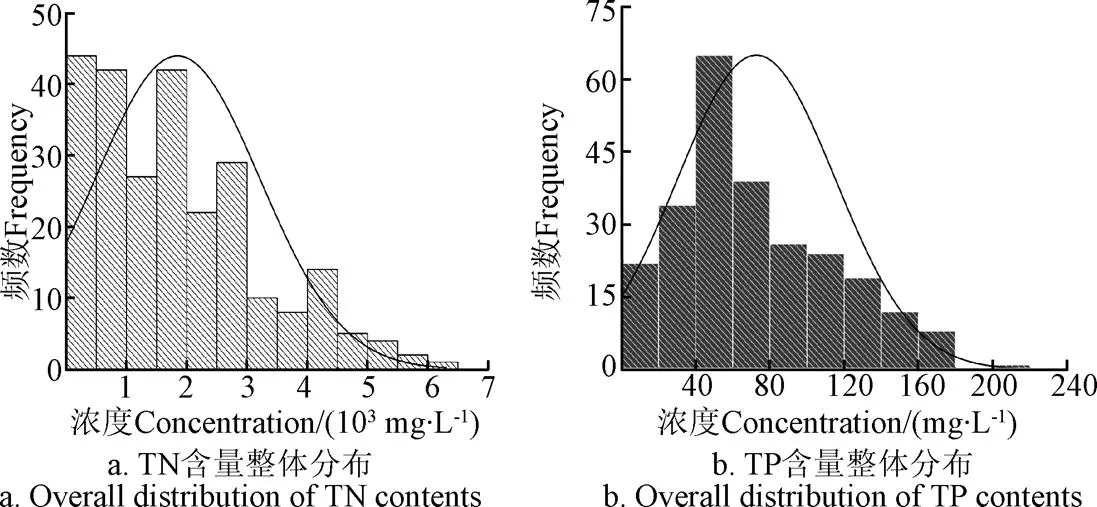
注:样品数n=250。
典型季节粪水中TN和TP含量变化特征如图4所示。春季TN含量数值分布较为离散,变异性较大,平均值在2 250 mg/L左右,与中位值相差较大;而秋季TN含量数值分布相对集中,平均值在1 500 mg/L左右,与中位值几乎重叠,且明显低于春季。可能是由于天津市春季气候多风、干旱、少雨,日平均气温不高,奶牛场各环节用水量总体较少,粪水处理系统运行相对稳定,氮素得以留存在水体中;而秋季降雨量相比春季多,日平均环境温度依然较高,氮素挥发量较大,同时由于奶牛舍区、挤奶车间仍然有喷淋水混入粪水处理系统,以及奶牛饮水量相对较大,洒落地面易混入系统,稀释了粪水中的氮素含量。
秋季TP含量数值分布相对均匀,平均值在80 mg/L左右,与中位值接近;而春季TP含量数值分布较为离散,平均值在65 mg/L左右,与中位值相差较大,且相比秋季略低。推测可能是由于整个夏季粪水储存期的磷素多被留存于秋季还田前,大多沉积在水体中下层,从而造成秋季粪水样品中的TP含量相对较高。综上,TN平均含量春季高于秋季,而TP平均含量相反,春秋季的TN和TP含量变化趋势差异较为明显,说明季节对粪水氮磷含量变化具有不同程度的影响。张帅等[31]研究中也指出奶牛场粪水氮磷含量受季节因素影响明显,与本研究结果相吻合。
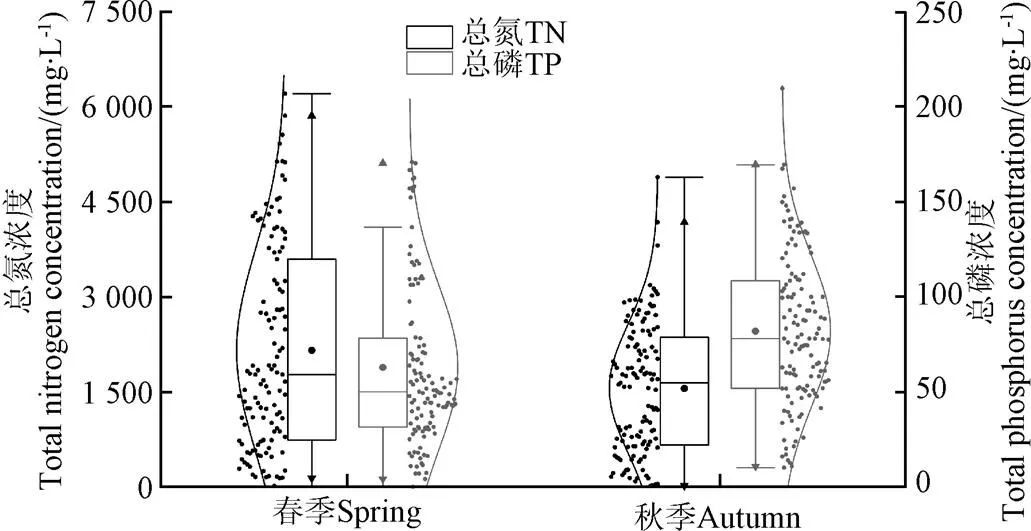
注:箱线图箱体中的横线表示中位值,实心圆表示均值,箱体两侧为正态曲线和数据点,箱体外存在异常值(▲)。春季样品数n=121,秋季样品数n=129。
2.2 近红外光谱主成分分析
2.2.1 近红外漫反射光谱
图5为从天津市27家规模化奶牛场粪水处理过程各环节采集的250个样品在4 000~12 000 cm-1范围内的原始近红外漫反射光谱。粪水样品含有C-H、N-H、O-H化学键的官能团,合频谱带位于5 210~4 200 cm-1处,一级倍频位于7 140~5 550 cm-1处,二级倍频位于10 400~8 200 cm-1处[32]。虽然待分析样品来自春秋2个季节的不同奶牛场,但近红外漫反射光谱在全波长范围内整体轮廓相似,仅在强度上存在差别,表明通过近红外漫反射光谱建立快速定量分析粪水氮磷含量的数学模型具有可行性。
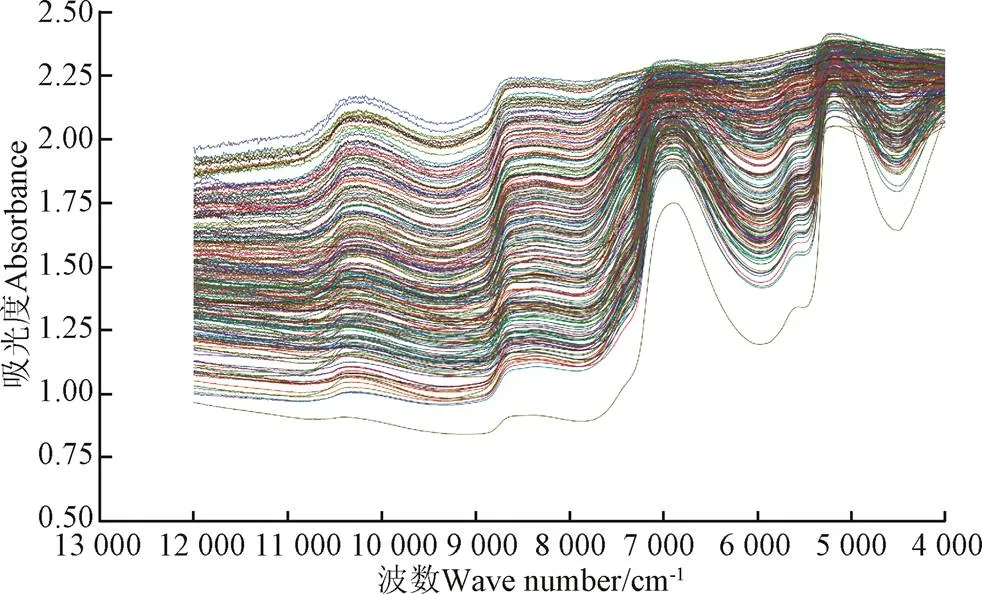
图5 粪水样品近红外漫反射光谱
2.2.2 主成分分析
为进一步明确2个季节不同奶牛场粪水处理过程中粪水样品之间的关联和特性差异,以及对于定量分析模型的影响,对天津市27家规模化奶牛场的春秋季共250个粪水样品的近红外漫反射光谱进行主成分分析(Principal Component Analysis,PCA)。在主成分得分图上,样品之间的距离越近,表明样品间的性质、组分越相似;距离越远,表明样品间性质、组分差异越大。因此,通过分析图上的样品分布,可推断奶牛场粪水样品组分含量随季节的变化。
图6为春秋2个季节250个粪水样品第一主成分(Principal Component 1,PC1)和第二主成分(Principal Component 2,PC2)的得分图,PC1和PC2解释光谱总变量的97.56%,其中PC1解释85.08%的光谱总变量,PC2解释12.48%的光谱总变量,表明PC1和PC2已提取了粪水样品的主要组分光谱信息。
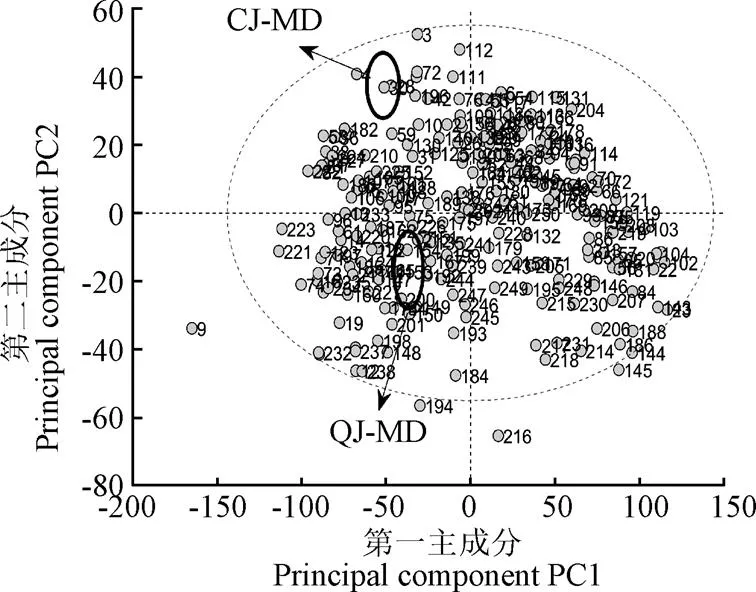
注:CJ、QJ分别代表春季、秋季,MD为某一家奶牛场简称缩写;数字代表样品所在样品集的编号。下同。
由图6可知,除春季9号样品外,其余249个样品分布在PC1 [−150,150]范围内;除秋季216号样品外,其余249个样品主要分布在PC2[−60,60]之间。样品在PC1和PC2得分图上的分布结果表明,249个样品的近红外漫反射光谱差异较大,即样品之间存在较大的差异性,说明季节因素对粪水样品的组分和含量均存在影响。由图6还可以观察到,同一奶牛场2个季节的粪水样品在PC1和PC2得分图上分布在不同区域,如QJ-MD(秋季-某一家奶牛场)的粪水样品主要分布在PC1<0和PC2<0的区域,而CJ-MD(春季-某一家奶牛场)的粪水样品主要分布在PC1<0和PC2>0的区域。上述分析结果进一步表明,季节因素对粪水样品的有机组分及含量存在影响。
为进一步探究季节因素对粪水样品近红外漫反射光谱的影响,分别对春秋2个季节样品进行独立的PCA分析。图7和图8分别为春秋2个季节粪水样品的近红外漫反射光谱PC1和PC2的得分图。春季PC1和PC2解释光谱总变量的98.76%,其中PC1解释89.79%的光谱总变量,PC2解释8.97%的光谱总变量;秋季PC1和PC2解释光谱总变量的96.72%,其中PC1解释83.76%的光谱总变量,PC2解释12.96%的光谱总变量。春季MD奶牛场在秋季PC1和PC2得分图上都位于PC1﹤0和PC2﹥0区域,在春季位于PC1﹥0和PC2﹤0区域,表明季节因素对粪水样品的组成和性质都存在影响,这与图6中春秋2个季节粪水样品融合PCA分析结果一致。

图7 春季121个粪水样品近红外光谱第一主成分与第二主成分得分图
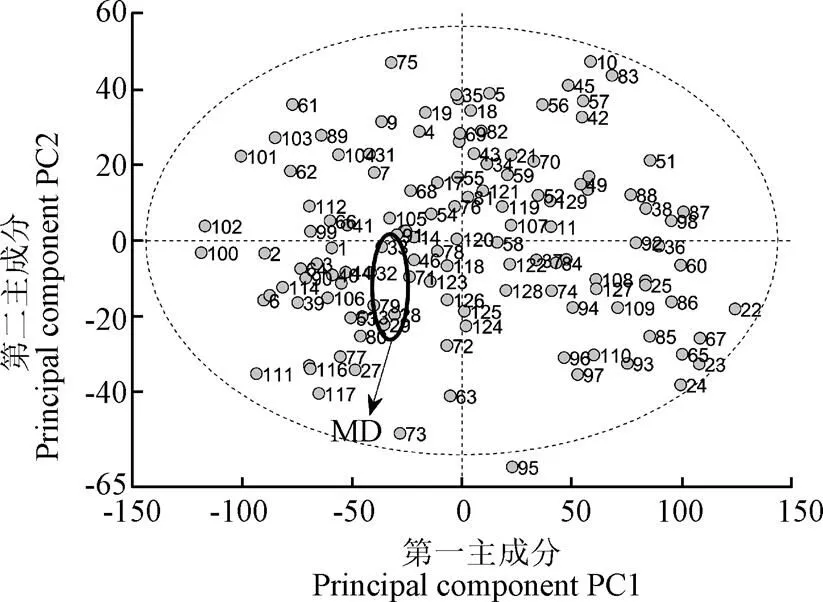
图8 秋季129个样品近红外光谱第一主成分与第二主成分得分图
2.3 模型效果分析及适用性评价
2.3.1 季节内模型预测效果分析
为研究季节因素对TN和TP定量分析结果的影响,首先建立了季节内模型,即校正集和预测集包含相同季节的样品。将校正集样品的近红外光谱矩阵与对应的氮磷浓度矩阵采用偏最小二乘(Partial Least Squares,PLS)算法[33-34]建立定量分析模型,并将预测集未知样品的近红外光谱矩阵代入所建立的PLS定量分析模型中,得到预测集未知样品中氮磷的浓度。图9和图10分别是春季、秋季和春秋融合模型对粪水中氮磷含量的预测结果。
对于粪水中的TN:春季模型校正集的均方根误差(Root Mean Square Error of Calibration,RMSEC)为335.32 mg/L、预测集的均方根误差(Root Mean Squared Error of Prediction,RMSEP)为338.26 mg/L、验证相关系数p=0.98、剩余预测偏差(Residual Predictive Deviation,RPD)为4.67(图9a);秋季模型RMSEC=331.55 mg/L、RMSEP=334.23 mg/L、p=0.94、RPD=2.83(图9b);春秋季融合模型RMSEC=325.35 mg/L、RMSEP= 382.29 mg/L、p=0.96、RPD=3.56(图9c)。
对于粪水中的TP:春季模型RMSEC=19.28 mg/L、RMSEP=20.04 mg/L、p=0.90,RPD=2.03(图10a);秋季模型RMSEC=23.42 mg/L、RMSEP=22.73 mg/L、p=0.81、RPD=1.68(图10b);春秋季融合模型RMSEC=24.91 mg/L、RMSEP =23.51 mg/L、p=0.83、RPD=1.80(图10c)。
从上述模型性能指标来看,春季氮磷含量预测模型总体优于秋季模型,说明不同季节对模型预测效果影响突出。

图9 季节内模型对粪水总氮含量的预测结果

图10 季节内模型对粪水总磷含量的预测结果
2.3.2 季节间模型预测效果分析
为进一步明确季节对模型的影响,建立了季节间模型,即校正集和预测集包含不同季节的样品。图11和图12分别是春秋季相互预测模型对粪水TN和TP的分析结果。对于粪水中TN:春季预测秋季模型RMSEP= 934.57 mg/L、p=0.92、RPD=2.28(图11a);秋季预测春季模型RMSEP=845.82 mg/L、p=0.97、RPD=2.58(图11b);对于粪水中TP:春季预测秋季模型RMSEP= 50.06 mg/L、p=0.48、RPD=0.94(图12a);秋季预测春季模型RMSEP=24.81 mg/L、p=0.84、RPD=1.64(图12b)。以上结果表明,季节间的模型预测效果并不理想。
2.3.3 不同模型的性能比较及因素分析
将季节内、季节间模型的预测性能评价指标列于表3,季节内模型预测效果总体优于季节间模型。其中,粪水TN 春季预测秋季模型的RMSEP达到了934.57 mg/L(图11a),秋季预测春季模型的RMSEP达到了845.82 mg/L(图11b),均高于单季模型和春秋融合模型;粪水 TP春季预测秋季模型的Rp仅为0.48(图12a),无法应用于粪水 TP 的预测;究其原因可能是春秋季节粪水样品的物质组成存在明显差异,氮磷含量分布不均匀,与2.1节中化学值的统计分析结果相吻合;且季节间校正集样品未完全覆盖预测集样品的浓度或性质,从而降低了模型的预测性能,造成预测结果较差。
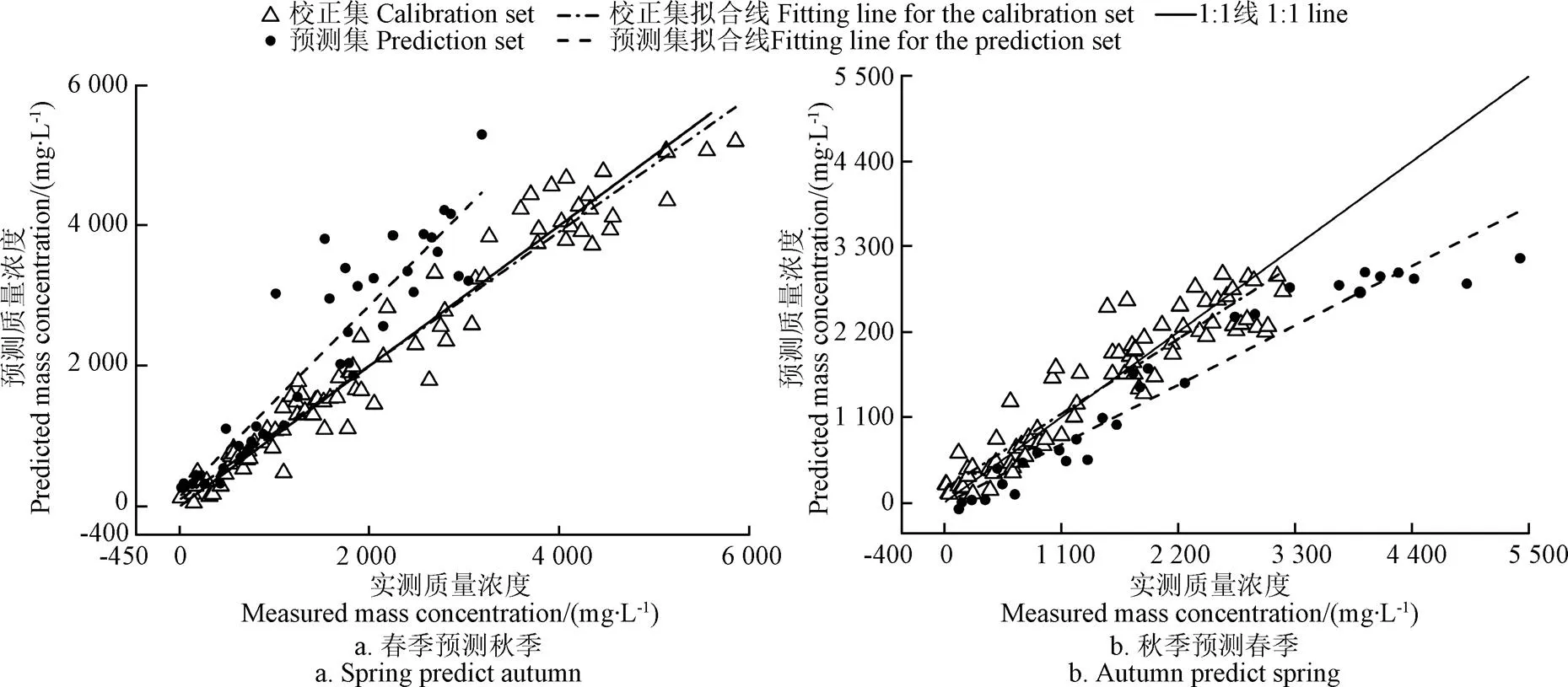
图11 季节间模型对粪水总氮含量的预测结果
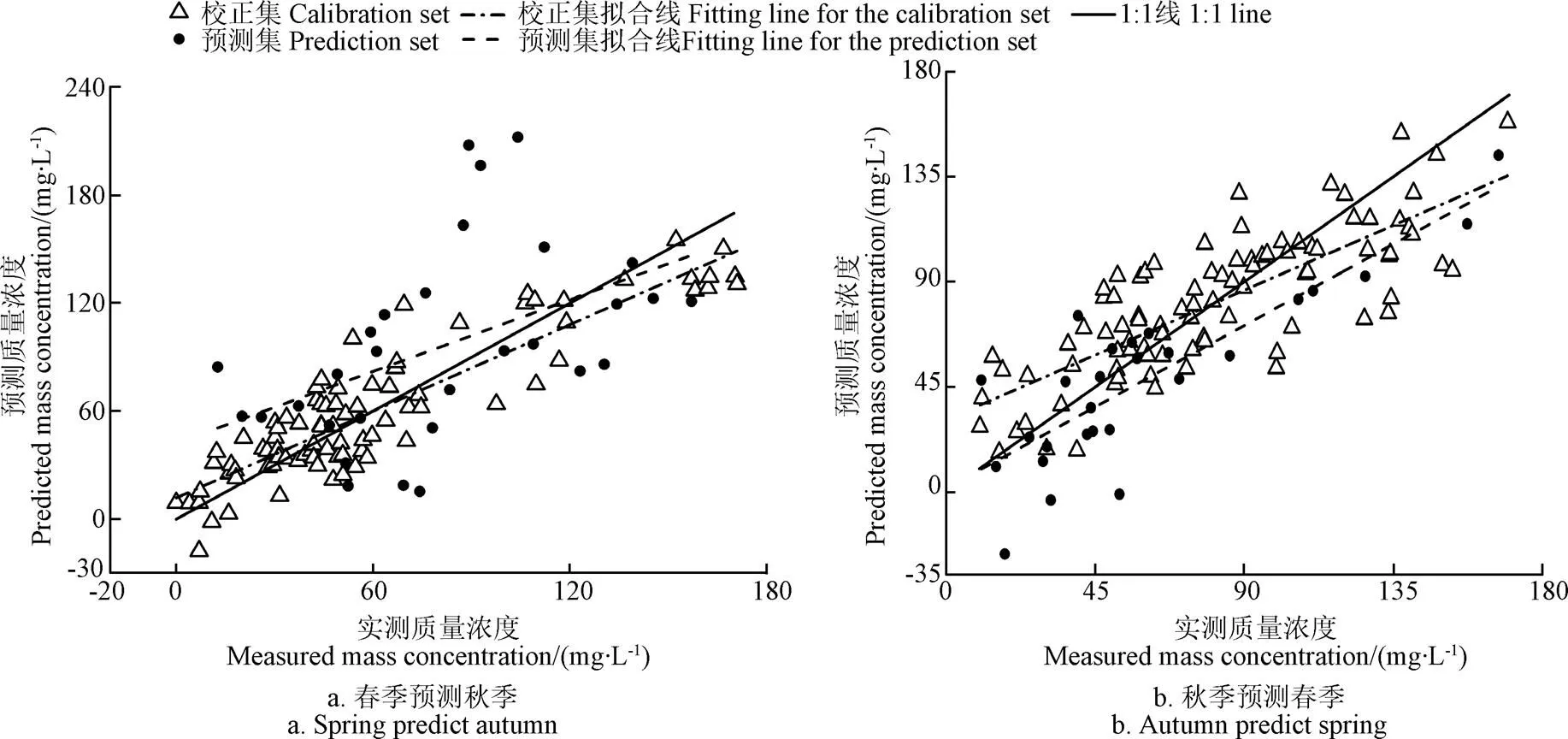
图12 季节间模型对粪水总磷含量的预测结果
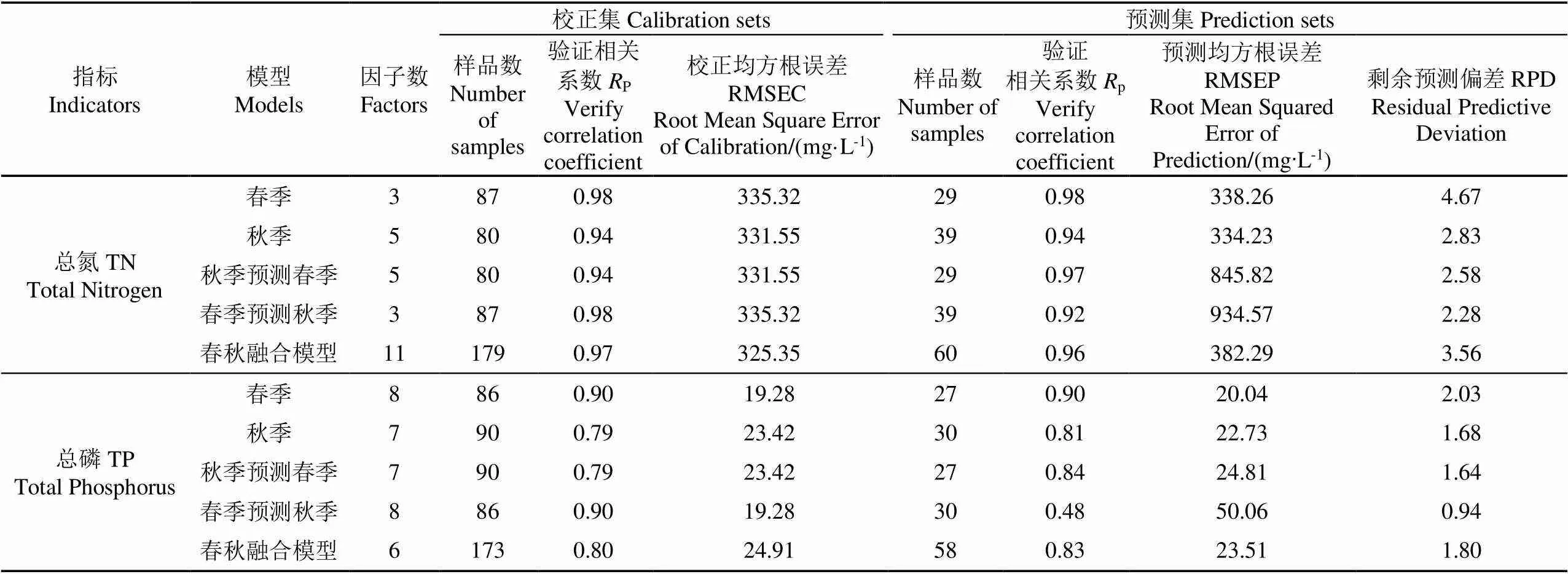
表3 不同模型的性能比较
从上述分析结果中可以得出,季节因素对定量分析规模化奶牛场粪水样品中的氮磷含量存在不同程度的影响,这与2.2节主成分分析结果一致。因此,需要建立全季节要素下的综合预测模型,以增强模型的适用性和稳定性,为普适型现场快速检测装备的研发提供技术支撑,破解众多规模化奶牛场不同情境下粪水氮磷现场快速定量化分析的技术难题,指导粪水安全科学还田的同时防控奶牛规模养殖环境污染风险。
3 结 论
本研究采用近红外光谱技术,对天津市春秋季27家规模化奶牛场粪水氮磷含量测定分析,通过对春季、秋季、春秋融合双季粪水样品进行化学值统计分析,近红外漫反射光谱主成分分析以及对季节内和季节间粪水氮磷模型预测结果进行定量分析,得出以下结论:
1)春秋双季对粪水氮磷含量存在不同程度的影响。
2)春秋单季和春秋融合模型均呈现出较好的预测结果,尤其春季模型,总氮预测均方根误差(Root Mean Squared Error of Prediction,RMSEP)为338.26 mg/L,验证相关系数p为0.98,剩余预测偏差(Residual Predictive Deviation,RPD)为4.67;总磷RMSEP为20.04 mg/L,p为0.90,RPD为2.03。
3)季节间粪水氮磷模型预测效果不及季节内和春秋融合模型,说明季节因素对粪水氮磷模型预测效果存在影响,下一步拟拓展全季节要素下的综合模型,建立实时跟踪监测粪水中氮磷含量的标准体系,为粪水安全还田提供技术支撑。
[1] 廖新俤. 欧美养殖废弃物管理对策比较及对我国养殖废弃物治理的启示[J]. 中国家禽,2017,39(4):1-3.
Liao Xindi. Comparison of management countermeasures on animal wastes between Europe and US and enlightenment to Chinese animal wastes management[J]. China Poultry, 2017, 39(4): 1-3. (in Chinese with English abstract)
[2] Ma Luning, Zhang Weifeng, Ma Wenqi, et al. An analysis of developments and challenges in nutrient management in China[J]. Journal of Environmental Quality, 2013, 42(4): 951-961.
[3] 刘玉满. 中国奶牛养殖业成长的烦恼:成也土地,败也土地[J]. 中国乳业,2018,203(11):2-7.
Liu Yuman. Growing trouble of dairy farming industry in China: Land for success and land for failure[J]. China Dairy Industry, 2018, 203(11): 2-7. (in Chinese with English abstract)
[4] Tariq M K, Claudio O S, Bryan R C, et al. Dairy-CropSyst: Gaseous emissions and nutrient fate modeling tool[J]. Computers and Electronics in Agriculture, 2019, 162: 962-978.
[5] Balde, H, VanderZaag A C, Burtt S D, et al. Ammonia emissions from liquid manure storages are affected by anaerobic digestion and solid-liquid separation[J]. Agricultural and Forest Meteorology. 2018, 258: 80-88.
[6] 张丽萍,刘红江,盛婧,等. 发酵周期、贮存时间和过滤对沼液养分和理化性状变化的影响[J]. 农业资源与环境学报,2018,35(1):32-39.
Zhang Liping, Liu Hongjiang, Sheng Jing, et al. Influence of anaerobic fermentation periods, storage time and filtration on the changes of nutrients and physical and chemical properties of biogas slurry[J]. Journal of Agricultural Resources and Environment, 2018, 35(1): 32-39. (in Chinese with English abstract)
[7] Chadwick D, Jia W, Tong Y A, et al. Improving manure nutrient management towards sustainable agricultural intensification in China[J]. Agriculture, Ecosystems & Environment, 2015, 209(1): 34-46.
[8] Bai Zhaohai, Ma Luning, Oenema Oene, et al. Nitrogen and phosphorus use efficiencies in dairy production in China[J]. Journal of Environment Quality, 2013, 42(4): 990-1001.
[9] 农业农村部办公厅. 2019年畜牧兽医工作要点(农办牧[2019]14号)[Z]. 2019.
[10] 农业农村部办公厅. 畜禽养殖废弃物资源化利用2019年工作要点(农办牧[2019]33号)[Z]. 2019.
[11] 农业农村部. 畜禽粪污资源化利用行动方案(2017-2020年)(农牧发[2017]11号)[Z]. 2017.
[12] 农业农村部办公厅,生态环境部办公厅. 关于促进畜禽粪污还田利用依法加强养殖污染治理的指导意见(农办牧[2019] 84号)[Z]. 2019.
[13] Amani M, Mobasheri M R, Mahdavi S. Contemporaneous estimation of leaf area index and soil moisture using the red-NIR spectral space[J]. Remote Sensing Letters, 2017, 9(3): 265-274.
[14] 陈奕云,齐天赐,黄颖菁,等. 土壤有机质含量可见-近红外光谱反演模型校正集优选方法[J]. 农业工程学报,2017,33(6):107-114.
Chen Yiyun, Qi Tianci, Huang Yingjing, et al. Optimization method of calibration dataset for VIS-NIR spectral inversion model of soil organic matter content[J]. Transactions of the Chinese Society of Agricultural Engineering (Transactions of the CSAE), 2017, 33(6): 107-114. (in Chinese with English abstract)
[15] She Chongchong, Li Min, Hou Yunhui, et al. Near infrared spectroscopy as an alternative method for rapid determination of the solidification point of 2,4,6-trinitrotoluene in production[J]. Journal of Near Infrared Spectroscopy, 2019, 27(4): 286-292.
[16] Nawar S, Mouazen A M. On-line vis-NIR spectroscopy prediction of soil organic carbon using machine learning[J]. Soil and Tillage Research, 2019, 190: 120-127.
[17] 陈彬,刘阁,张贤明. 连续投影算法的润滑油中含水量的近红外光谱分析[J]. 红外与激光工程,2013,42(12):3168-3174.
Chen Bin, Liu Ge, Zhang Xianming. Analysis on near infrared spectroscopy of water content in lubricating oil using successive projections algorithm[J]. Infrared and Laser Engineering, 2013, 42(12): 3168-3174. (in Chinese with English abstract)
[18] 荣海腾,宋春风,袁洪福,等. 近红外光谱法快速测定车用汽油中多种添加剂含量[J]. 光谱学与光谱分析,2015,35(10):2757-2760.
Rong Haiteng, Song Chunfeng, Yuan Hongfu, et al. Rapid quantitative analysis of content of the additive in gasoline for motor vehicles by near-infrared spectroscopy[J]. Spectroscopy and Spectral Analysis, 2015, 35(10): 2757-2760. (in Chinese with English abstract)
[19] 李鸿强,孙红,李民赞. 基于可见/短波近红外光谱检测结球甘蓝维生素C含量[J]. 农业工程学报,2018,34(8):269-275.
Li Hongqiang, Sun Hong, Li Minzan. Detection of vitamin C content in head cabbage based on visible/near-infrared spectroscopy[J]. Transactions of the Chinese Society of Agricultural Engineering (Transactions of the CSAE), 2018, 34(8): 269-275. (in Chinese with English abstract)
[20] Qiao Lu, Tang Xiuying, Dong Jun. A feasibility quantification study of total volatile basic nitrogen (TVB-N) content in duck meat for freshness evaluation[J]. Food Chemistry, 2017, 237: 1179-1185.
[21] Abdel G S, Shyam N J, Pranita J, et al. On-destructive quality monitoring of stored tomatoes using VIS-NIR spectroscopy[J]. Engineering in Agriculture Environment and Food, 2016, 9(2): 158-164.
[22] Nirea K G, Pérez de Nanclares M, Adrijana S, et al. Assessment of fecal near-infrared spectroscopy to predict feces chemical composition and apparent total-tract digestibility of nutrients in pigs[J]. Journal of Animal Science, 2018, 96(7): 2826-2837.
[23] Hassouna M, Robin P, Charpiot A, et al. Infrared photoacoustic spectroscopy in animal houses: Effect of non-compensated interferences on ammonia, nitrous oxide and methane air concentrations[J]. Biosystems Engineering, 2013, 114(3): 318-326.
[24] Decruyenaerea V, Planchonbc V, Dardenne P. Prediction error and repeatability of near infrared reflectance spectroscopy applied to faeces samples in order to predict voluntary intake and digestibility of forages by ruminants[J]. Animal Feed Science and Technology, 2015, 205: 49-59.
[25] Casale M, Oliveri P, Casolino C, et al. Characterization of PDO olive oilby non-selective (UV-visible, NIR and MIR spectroscopy) and selective (fatty acid composition) analytical techniques[J]. Analytica Chimica Acta, 2012, 712(27): 56-63.
[26] Finzi A, Oberti R, Negri A S, et al. Effects of measurement technique and sample preparation on NIR spectroscopy analysis of livestock slurry and digestates[J]. Biosystems Engineering, 2015, 134: 42-54.
[27] 赵润,刘海学,王鹏,等. 基于近红外漫反射光谱的规模化奶牛场粪水氮磷定量分析及模型构建[J]. 农业环境科学学报,2019,38(8):1768-1776.
Zhao Run, Liu Haixue, Wang Peng, et al. Quantified analysis and model structure of nitrogen and phosphorus in the slurry of large-scale dairy farms based on near-infrared transmission-diffuse reflectance spectroscopy[J]. Journal of Agro-Environment Science, 2019, 38(8): 1768-1776. (in Chinese with English abstract)
[28] 国家质量监督检验检疫总局,国家标准化管理委员会. 畜禽养殖污水采样技术规范:GB/T 27522-2011[S]. 北京:中国标准出版社,2011.
[29] 国家环境保护局标准处. 水质凯氏氮的测定:GB 11891-1989 [S]. 北京:中国质检出版社,1989.
[30] 国家环境保护局标准处. 水质总磷的测定钼酸铵分光光度法:GB 11893-1989 [S]. 北京:中国环境出版有限责任公司,1989.
[31] 张帅,陆鹏,陈硕,等. 京郊畜禽粪污氮磷含量特征及影响因素分析[J]. 农业工程学报,2018,34(8):244-251.
Zhang Shuai, Lu Peng, Chen Shuo, et al. Characteristics of nitrogen and phosphorus content and analysis of its influencing factors in feces and wastewater of livestock farms in Beijing suburb[J]. Transactions of the Chinese Society of Agricultural Engineering (Transactions of the CSAE), 2018, 34(8): 244-251. (in Chinese with English abstract)
[32] 褚小立. 近红外光谱分析技术实用手册[M]. 北京:机械工业出版社,2016:4-7.
[33] Wold S, Sjöström M, Eriksson L. PLS-regression: A basic tool of chemometrics[J]. Chemometrics & Intelligent Laboratory Systems, 2001, 58(2): 109-130.
[34] Burns D A, Ciurczak E W. Handbook of Near-Infrared Analysis, Third Edition[M]. Boca Raton: CRC Press, 2007: 189-205.
Influences of spring and autumn on the nitrogen and phosphorus contents of the slurry predicted by near-infrared spectrum model on dairy farms
Sun Di1, Yang Renjie2, Li Mengting3, Mu Meirui2, Li Mingtang1, Zhang Keqiang3, Zhao Run3※
(1.,,130118; 2.,300384; 3.,300191)
Returning to the field was the optimal way out for the great deal of slurry from dairy farms in China at the moment. Nitrogen and phosphorus were important nutrient measurable indicators. Variation in nitrogen and phosphorus content was influenced by many natural factors involved in temperature, wind speed, and rainfall so that it was hard to quickly and accurately quantify, leading to the difficulty of returning the slurry to the field. Therefore, aimed at learning the influence of typical seasonal factors on the variation of nitrogen and phosphorus contents in the slurry of large-scale dairy farms together with the prediction results of near-infrared spectroscopy models, it was significantly meaningful that provide the basis of setting up the testing method and standard system for guiding them safely and scientifically returning the slurry to the field. 250 slurry samples were gathered in the whole process of slurry treatment from 27 large-scale dairy farms in Tianjin both in spring and autumn. The influence of season on the distribution characteristics of chemical values of nitrogen and phosphorus in the slurry was analyzed, meanwhile the near-infrared spectra of the whole samples were collected and subjected to the principal component analysis. Then the Partial Least Squares (PLS) was used to establish the seasonal models that involved the spring model, autumn model, and mixed model of both, as well as the demi-season models for the quantified analysis of the nitrogen and phosphorus contents in the slurry. The results showed that the nitrogen and phosphorus contents of the samples appeared varying degrees of variability with seasonal changes. In the seasonal models, the Root Mean Squared Error of prediction set (RMSEP) of three Total Nitrogen (TN) models was 338.26, 334.23, and 382.29 mg/L, respectively. The correlation coefficients of calibration set (p) was 0.98, 0.94, and 0.96, respectively. The Residual Predictive Deviations (RPD) was 4.67, 2.83, and 3.56, respectively. RMSEP of three Total Phosphorus (TP) models was 20.04, 22.73, and 23.51 mg/L, respectively.pwas 0.90, 0.81 and 0.83, respectively. RPD was 2.03, 1.68, and 1.80, respectively. As a whole, the spring model showed a better result than the autumn model, which highlighted the effect of seasonal influence on the prediction. RMSEP of two TN models for mutual prediction between spring and autumn was 934.57 and 845.82 mg/L, respectively.pwas 0.97 and 0.92, respectively. RPD was 2.28 and 2.58, respectively. RMSEP of two TP models for mutual prediction between spring and autumn was 50.06 and 24.81 mg/L, respectively.pwas 0.84 and 0.48, respectively. RPD was 0.94 and 1.64, respectively. The overall effect of the demi-season model was inferior compared to the seasonal models. And the performance of the demi-season model was too poor to be used for the determination of nitrogen and phosphorus content in the slurry. In summary, the interior seasonal model of nitrogen and phosphorus in the slurry was superior to the demi-season model and the prediction results of the nitrogen and phosphorus model in the slurry were influenced by the seasonal factors. All the results indicated that the nitrogen and phosphorus contents of slurry were influenced by the seasons. Further objective would be designed to establish the comprehensive forecast models with overall seasonal elements to enhance the feasibility and stability of models that providing the technical support for the development of portable measurement facilities, breaking through the dilemma of quantified analysis under the complicated situation in numerous intensive dairy farms, leading to the slurry recycling back to the field in safely and scientifically meanwhile controlling over the environmental pollution risk.
nitrogen; phosphorus; slurry; large-scale dairy farms; near-infrared spectroscopy; partial least squares; interior seasonal model; demi-season model
孙迪,杨仁杰,李梦婷,等. 春秋季对近红外光谱模型预测奶牛场粪水氮磷含量结果的影响[J]. 农业工程学报,2020,36(10):197-205.doi:10.11975/j.issn.1002-6819.2020.10.024 http://www.tcsae.org
Sun Di, Yang Renjie, Li Mengting, et al. Influences of spring and autumn on the nitrogen and phosphorus contents of the slurry predicted by near-infrared spectrum model on dairy farms[J]. Transactions of the Chinese Society of Agricultural Engineering (Transactions of the CSAE), 2020, 36(10): 197-205. (in Chinese with English abstract) doi:10.11975/j.issn.1002-6819.2020.10.024 http://www.tcsae.org
2020-03-06
2020-04-13
国家重点研发计划(2018YFD0800100);国家自然科学基金(41771357,21607114,81471698);天津市现代奶牛产业技术体系创新团队建设专项(ITTCRS2017006);天津市自然科学基金(18JCYBJC96400,16JCQNJC08200)联合资助
孙迪,主要从事固体废弃物处理等方面研究。Email:sdi0825@126.com
赵润,博士,助理研究员,主要从事规模化奶牛场环境监测等方面研究。Email:15900389657@163.com
10.11975/j.issn.1002-6819.2020.10.024
X713
A
1002-6819(2020)-10-0197-09

